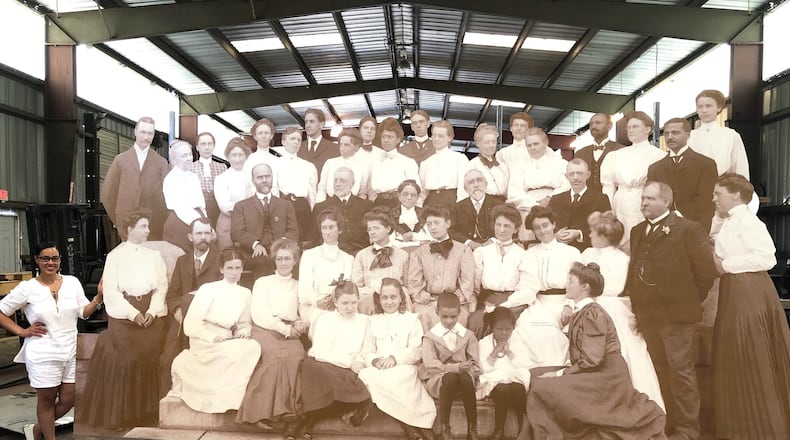Back then, when the photo was taken, Morris Brown College’s Fountain Hall was covered in ivy.
All of the women pictured, teachers and wives of men affiliated with Atlanta University, wore white shirts.
The men — including scholar, writer and activist W.E.B. Du Bois, who is almost hidden on the back row — were in black suits.
Most look away from the camera, as was the practice at the turn of the last century.
The 17-by-8-foot cutout image of the faculty of Atlanta University, taken circa 1906 on Morris Brown’s campus, is an art project unveiled Tuesday by historian Karcheik Sims-Alvarado. The project is on exhibit at the very place the picture was taken – at the front steps of the now dilapidated Fountain Hall.
»RELATED GALLERY: Morris Brown College through the years
The photo is not a new discovery – in fact, it is in at least three historic collections. But, for the display, Sims-Alvarado enlarged it 19 times the original size.
The black-and-white photo offers a reminder of better days for the beleaguered Morris Brown College, when it was considered one of the best historically black colleges and universities in the country and shared faculty and resources with the other colleges that make up what is now the Atlanta University Center.
The only HBCU in Georgia founded by African Americans, Morris Brown lost its accreditation in 2002 and enrolled fewer than 50 students last semester. That’s from a high of 2,700 in the mid-1990s.
Kevin James, the new president of Morris Brown, is working on getting the school accredited through the Transnational Association of Christian Colleges and Schools. Separately, James said a $5 million capital campaign has raised about $300,000 since March.
»RELATED: A timeline of the life and near-death of Morris Brown College
On top of that, the school is trying to raise $100,000 to repair damages from a fire earlier this month.
“It has been challenging, but we are moving forward,” James said.
Many of the buildings that made up Morris Brown have burned down or been torn down or abandoned – like Fountain Hall.
Built in 1882, it is the oldest surviving building associated with Morris Brown and the old Atlanta University, which merged with Clark College in 1988 to form Clark Atlanta University.
Sitting majestically atop one of the highest peaks in Atlanta, the clock on the three-story classroom building can be seen for miles and once chimed every hour. The building, a National Historic Landmark, is boarded up and hasn’t been used for years.
“The photograph will be a gift to the college to get them to call attention to the building and to get people to think about the preservation of the building,” said Sims-Alvarado, adding that her art project was funded with a $5,000 grant from the Atlanta Housing Authority as part of the Choice Neighborhoods Initiative.
»RELATED: Born in the North but HBCUs most needed in the South
The original photograph, which was borrowed from the Herndon Home Museum, was taken in either 1905 or 1906 by noted black Atlanta photographer Thomas E. Askew.
It captures, she said, “the elegance and beauty of the Atlanta University administration, faculty, and their family.”
Sims-Alvarado, the author of “Atlanta and the Civil Rights Movement, 1944-1968,” said the striking thing about the photo is the diversity of the faculty, which she called a “defiance of Jim Crow oppression.”
»RELATED: When HBCUs fail, a short history of what we lost
Along with Du Bois, the imminent scholar whose first stint teaching at Atlanta University spanned from 1897 until 1910, the photo also includes: Alonzo Herndon, the founder and president of the Atlanta Life Insurance Company and the city’s first black millionaire; Atlanta University President Horace Bumstead, a white Congregationalist minister and educator; and George Alexander Towns, a poet and playwright who taught English at Atlanta University.
“I see black excellence. I see family. I see scholars. I see individuals who are building the future of the Atlanta University Center and Morris Brown,” James said. “We stand on their shoulders, those who poured into the AUC. That is the reason why I am not giving up on Morris Brown College. We are going to restore this institution.”
HOW TO SEE IT:
The 17-by-8-foot cutout image will be on display indefinitely on the campus of Morris Brown College in front of the steps of Fountain Hall where it was taken more than 100 years ago.
It can be visited anytime on campus at: Morris Brown College, 643 Martin Luther King Jr. Drive.
About the Author
Keep Reading
The Latest
Featured







